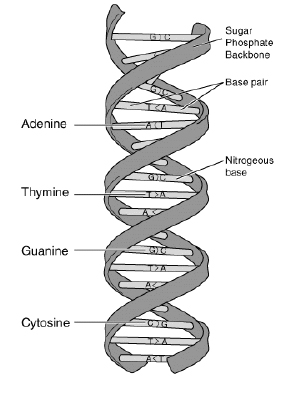 Figure 1. DNA (Deoxyribonucleic Acid) is the molecule which contains the genetic instructions. It consists of four different
nucleotides, namely Adenine, Thymine, Guanine, and Cytosine as shown in Figure 1. If we represent a nucleotide by its initial character, a DNA strand can be regarded as a long string (sequence of characters) consisting of the four characters A, T, G, and C.
For example, assume we are given some part of a DNA strand which is composed of the following sequence of nucleotides:
Figure 1. DNA (Deoxyribonucleic Acid) is the molecule which contains the genetic instructions. It consists of four different
nucleotides, namely Adenine, Thymine, Guanine, and Cytosine as shown in Figure 1. If we represent a nucleotide by its initial character, a DNA strand can be regarded as a long string (sequence of characters) consisting of the four characters A, T, G, and C.
For example, assume we are given some part of a DNA strand which is composed of the following sequence of nucleotides:
``Thymine-Adenine-Adenine-Cytosine-Thymine-Guanine-Cytosine-Cytosine-Guanine-Adenine-Thymine"
Then we can represent the above DNA strand with the string ``TAACTGCCGAT." The biologist Prof. Ahn found that a gene X commonly exists in the DNA strands of five different kinds of animals, namely dogs, cats, horses, cows, and monkeys. He also discovered that
the DNA sequences of the gene X from each animal were very alike. See Figure 2.
| DNA sequence of gene X | |
| Cat: | GCATATGGCTGTGCA |
| Dog: | GCAAATGGCTGTGCA |
| Horse: | GCTAATGGGTGTCCA |
| Cow: | GCAAATGGCTGTGCA |
| Monkey: | GCAAATCGGTGAGCA |
Prof. Ahn thought that humans might also have the gene X and decided to search for the DNA sequence of X in human DNA. However, before searching, he should define a representative DNA sequence of gene X because its sequences are not exactly the same in the
DNA of the five animals. He decided to use the Hamming distance to define the representative sequence. The Hamming distance is the number of different characters at each position from two strings of equal length. For example, assume we are given the two strings
``AGCAT" and ``GGAAT." The Hamming distance of these two strings is 2 because the 1st and the 3rd characters of the two strings are different. Using the Hamming distance, we can define a representative string for a set of multiple strings
of equal length. Given a set of strings S = s1,...,
sm of length n , the consensus error between a string
y of length n and the set
S is the sum of the Hamming distances between
y and each si in
S . If the consensus error between y and
S is the minimum among all possible strings
y of length n ,
y is called a consensus string of S . For example, given the three strings ``
AGCAT" `` AGACT" and `` GGAAT" the consensus string of the given strings is ``
AGAAT" because the sum of the Hamming distances between `` AGAAT" and the three strings is 3 which is minimal. (In this case, the consensus string is unique, but in general, there can be more than one consensus string.) We use the consensus
string as a representative of the DNA sequence. For the example of Figure 2 above, a consensus string of gene X is ``
GCAAATGGCTGTGCA" and the consensus error is 7.
3 5 8 TATGATAC TAAGCTAC AAAGATCC TGAGATAC TAAGATGT 4 10 ACGTACGTAC CCGTACGTAG GCGTACGTAT TCGTACGTAA 6 10 ATGTTACCAT AAGTTACGAT AACAAAGCAA AAGTTACCTT AAGTTACCAA TACTTACCAA
TAAGATAC
7
ACGTACGTAA
6
AAGTTACCAA
12
题目大意:给定m个长度为n的DNA序列,求一个DNA序列,使其到所有序列的总hamming距离尽量小,如有多解,输出最小解。
#include<stdio.h>
#include<string.h>
#include<algorithm>
using namespace std;
char str[55][1005], ans[1005];
int n, m, temp[30], ACGT[4] = {0, 2, 6, 19};
int main() {
int T;
scanf("%d\n", &T);
while (T--) {
memset(str, 0, sizeof(str));
memset(ans, 0, sizeof(ans));
scanf("%d %d\n", &n, &m);
for (int i = 0; i < n; i++) {
scanf("%s\n", str[i]);
}
int cnt = 0, max, sum = 0, num;
char ch;
for (int i = 0; i < m; i++) {
memset(temp, 0, sizeof(temp));
max = 0;
for (int j = 0; j < n; j++) {
temp[str[j][i] - 'A']++;
}
for (int j = 0; j < 4; j++) {
if (max < temp[ACGT[j]]) {
max = temp[ACGT[j]];
ch = ACGT[j] + 'A';
num = n - temp[ACGT[j]];
}
}
sum += num;
ans[cnt++] = ch;
}
printf("%s\n%d\n", ans, sum);
}
return 0;
}
uva 1368 - DNA Consensus String(字符串处理)
原文地址:http://blog.csdn.net/llx523113241/article/details/43370583